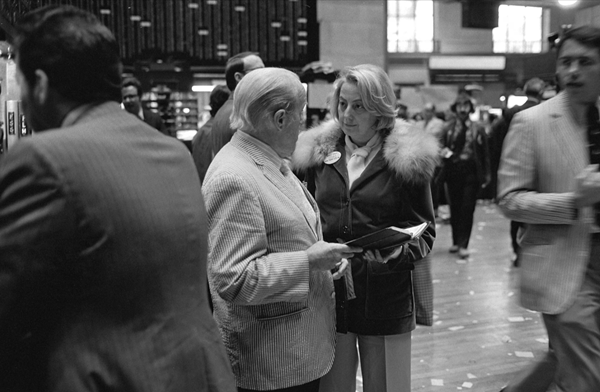Women Who Shattered Wall Street's Glass Ceiling

The propulsive story of the women who sought, and gained, a piece of the action on Wall Street.
1. The Paulina Bren [Blog site]
2. Bernadette Bartels Murphy, Pioneering Wall Street Trader, Dies at 86 [New York Times]
3. Tracing the Roots of the Women on Wall Street [National Women’s History Museum]
4. How the macho NYSE trader became an endangered species [New York Post]
Contact That's Life, I Swear
- Visit my website: https://www.thatslifeiswear.com
- Twitter at @RedPhantom
- Bluesky at @rickbarron.bsky.social
- Email us at https://www.thatslifeiswear.com/contact/
Episode Review
- Submit on Apple Podcast
- Submit on That's Life, I Swear website
Other topics?
- Do you have topics of interest you'd like to hear for future podcasts? Please email us
Listen to podcast audios
- Apple https://apple.co/3MAFxhb
- Spotify https://spoti.fi/3xCzww4
- My Website: https://bit.ly/39CE9MB
Other
- Music and/or Sound Effects are courtesy of Pixabay
Thank you for following the That's Life I Swear podcast!!
⏱️ 16 min read
Visualize stepping into a world where power is hoarded, deals are made behind closed doors, and the odds are stacked against you—because of your gender. For decades, Wall Street’s elite belonged to men, and women weren’t just outsiders—they were unwelcome.
But some women refused to accept that fate. They didn’t just break into the old boys’ club, they changed the rules, forever reshaping the world of finance. These trailblazing pioneers fought their way to the top by breaking the proverbial glass ceiling—and stayed.
Welcome to That's Life, I Swear. This podcast is about life's happenings in this world that conjure up such words as intriguing, frightening, life-changing, inspiring, and more. I'm Rick Barron your host.
That said, here's the rest of this story
This story stems from a book written by Paulina Bren. The book is titled She-Wolves, The Untold History of Women on Wall Street.
Book author, Paulina Bren
In She-Wolves, acclaimed historian Paulina Bren chronicles the groundbreaking journey of several women who broke into the male-dominated world of Wall Street, from the vibrant 1960s through the aftermath of 9/11. Bren traces their rise in an era when signs reading "No Ladies" barred women from luncheon clubs and, less visibly, from the inner sanctums of brokerage firms and investment banks.
What follows is but a small sampling of this incredible story.
So, let’s start at the beginning. The 1950s and 1960s marked the advent of women in the financial sector, particularly on Wall Street. To have any hope of advancing in this male-dominated field, female professionals had to adhere to an unwritten set of rules.
At that time, the term "Wall Street" literally referred to the narrow street in lower Manhattan and its immediate surroundings. This compact area housed not only industry giants like JP Morgan, Goldman Sachs, Lehman Brothers, Merrill Lynch, and Bear Stearns, but also many smaller financial firms.
Like every average workday, the subway doors open and dozens of women employed as secretaries, teletypists, and data-entry clerks, made the march to the New York Stock Exchange. Dressed in their best business attire, these brave souls ventured into a world overwhelmingly controlled by men. Smaller brokerage houses often provided the initial stepping stones for those aspiring to climb the corporate ladder, but even that was limited.
The environment these women faced was far from welcoming. They endured numerous challenges, most of which were blatant and impossible to ignore. The prevalent culture of midday drinking, epitomized by the infamous two-martini lunch, only served to amplify these difficulties.
In the1950s, Bernadette Murphy found herself navigating two familiar yet contrasting worlds. Hailing from City Island, a maritime enclave in the Bronx, she felt an odd comfort in Wall Street's salt air - a scent reminiscent of her childhood home. However, her role as a trading department assistant, handling trade orders and correspondence for the firm's partners, thrust her into a very unwelcoming environment.
The office atmosphere was rife with inappropriate behavior. Emboldened by the era's lax of professional standards, male colleagues would proposition Murphy with lavish offers. Promises of Parisian getaways or extravagant wardrobes were dangled before her, thinly veiling requests for intimate favors. Murphy's retort became a well-worn refrain, echoed by countless women across numerous offices for years to come: "Don't be silly! What would your wife say?"
This sharp, deflecting response served as a makeshift shield in an era when the concept of sexual harassment had yet to be legally recognized or defined. Murphy's experience was far from unique; it was a shared narrative among professional women of her time, silently enduring and deflecting advances that would be grounds for termination in today's workplace.
Navigating the path of Wall Street in those days required women to possess an unwavering resolve and an impenetrable emotional armor. Success hinged on their ability to deflect unwanted advances while simultaneously striving to capture positive professional attention. Career advancement became a possibility for those who managed this delicate balancing act.
Beth Dater's journey exemplifies this narrative. Her path to Wall Street was anything but conventional. After graduating from Boston University, Dater took to the skies as a Pan Am flight attendant. Her career trajectory shifted in the late 1960s when she married a pilot who requested she ground her flying aspirations.
Seeking new employment, Dater found herself at the mercy of a temp agency's eclectic job offerings. Her initial assignment was far from glamorous - donning a Miss Mon Cheri costume to distribute chocolate-cherry bonbons in a parking lot. However, fate soon intervened, landing her a position operating the phones at the office of Lehman Brothers.
This seemingly mundane role as a receptionist became Dater's gateway into the financial world. Like many of her female contemporaries on Wall Street, she leveraged this position to observe, absorb, and comprehend the industry's intricacies. Her keen intellect and determination did not go unnoticed, and before long, she found herself auditioning for a coveted role as a research analyst-in-training at Fiduciary Trust Company.
Dater's story underscores a common thread in the experiences of early female Wall Street professionals - the ability to transform even the most modest opportunities into stepping stones for career advancement.
Research analysts blazed the trail in the ascent of women on Wall Street. Their ability to conceal their gender behind initials provided a unique advantage, allowing them to be perceived as either male or gender-neutral. This anonymity became a powerful tool in their professional arsenal.
The 1970 New York City Human Rights Commission hearings shed light on Wall Street's hiring practices, compelling firms to confront their gender biases. Among the major players, Merrill Lynch stood out, boasting a contingent of seven female industry specialists out of 26 - a ratio that, while far from equal, was progressive for its time.
One of these trailblazers, Mary Wrenn, reflected on her experience: "For a long time, those who read my reports didn't know whether I was Miss or Mr. Wrenn." This ambiguity, whether intentional or not, often worked in women's favor, allowing their work to be judged on merit alone.
The following year, Mary Farrell entered the Wall Street arena, albeit through an unexpected route. Responding to an advertisement for a securities analyst trainee at Pershing & Co., Farrell initially mistook it for a theater-related position due to the firm's Broadway address. Her hiring, however, was less advantageous than it appeared.
The director at Pershing & Co. had stumbled upon what he considered a wise business strategy - hiring women to secure talented individuals at a lower cost. This tactic, while exploitative, inadvertently opened doors for women like Farrell to enter and eventually reshape the male-dominated world of finance.
At Smith Barney, an incident unfolded for Mary in an elevator - an executive assaulted her, pushing her against the wall and groping her. Seeking recourse, she approached the HR director, only to find her in tears, having endured a similar experience that very day. The aftermath was swift and unsettling. By Monday, the HR director had vanished, but not before leaving Mary a revealing parting gift on her desk: a list of departmental salaries. The stark reality hit Mary - her compensation was precisely half that of the lowest-paid male analyst.
For some women in the industry, even this inequitable pay seemed attractive, surpassing the earnings of most American women at the time. However, such disparity ignited fury in trailblazers like Muriel "Mickie" Siebert. Arriving in New York in 1954 in a dilapidated Studebaker, Siebert had rapidly ascended the ranks as a successful airline industry analyst. Yet she recognized that the real wealth lay in trading - a domain entirely off-limits to women.
Muriel Siebert, Courtesy of: Wall Street Journal
Siebert's ambitions were met with resistance at major firms. Despite her expertise, she was told she'd still be relegated to sitting with typists instead of at the decision-making table. This frustration led to an unconventional suggestion from a friend: why not purchase her own seat on the New York Stock Exchange?
The New York Stock Exchange's constitution, in an oversight by its founders, did not explicitly exclude women. This loophole paved the way for a historic moment on December 28, 1967, when Muriel "Mickie" Siebert shattered the glass ceiling, becoming the first female NYSE member. Her triumph came at a steep price - nearly half a million dollars for a white metal badge emblazoned with the number 2646 in red. Siebert wryly dubbed it "the most expensive piece of jewelry going."
Despite this breakthrough, Siebert treaded carefully, vowing not to set foot on the trading floor to avoid potential conflicts. Instead, she conducted her business through a male proxy - an independent "two-dollar" floor broker.
What is a Two-Dollar Broker?
A two-dollar broker is an outdated term used for a member of the New York Stock Exchange (NYSE) who managed trades and executed orders for another broker’s client. A broker might choose to have a two-dollar broker do business for them because the trader is too busy to take on the work themselves.
It wasn't until almost a decade later, in 1976, that Alice Jarcho made history as the first woman to trade on the NYSE floor actively. However, Jarcho's groundbreaking role came with unforeseen challenges that validated Siebert's earlier caution. She faced a barrage of lewd remarks, received inappropriate objects via pneumatic tubes, and even required temporary police protection due to anonymous threats.
By 1980, when Jarcho transitioned from the NYSE floor to second-in-command on the Shearson American Express institutional trading desk, the landscape of Wall Street and higher education was on the cusp of a dramatic transformation. Business schools were witnessing a surge in female enrollment, a stark contrast to 1963 when Harvard Business School admitted its first cohort of eight women, who were met with skepticism and interrogated about "taking spots from legitimate breadwinners."
This period marked the beginning of a seismic shift in the financial sector. The pioneers who braved hostility and discrimination were paving the way for a new generation of women in finance. Their perseverance was gradually reshaping both Wall Street and academic institutions, challenging long-held notions about gender roles in the world of high finance.
The 1980s ushered in a new era on Wall Street, marked by an influx of female graduates from prestigious institutions. Ivy League universities and top-tier business schools began producing a wave of ambitious women, eager to make their mark in the financial world. This sudden surge resembled a modern-day gold rush, with bright-eyed newcomers flooding into an industry long dominated by men.
Beth Dater, a seasoned professional known for her impeccable attire, observed this transformation with amusement and unease. She couldn't help but raise an eyebrow at the sight of these young women, their practical sneakers paired incongruously with business suits, office heels discreetly tucked away in monogrammed Lands' End canvas totes. Despite her established position, Dater felt a twinge of insecurity, acutely aware that she lacked an MBA unlike these newcomers.
This changing landscape signaled the end of an era. The difficult path walked by Dater and her contemporaries - many of whom had forged successful careers without completing college, transforming support roles into launching pads for advancement - was rapidly disappearing. The emerging archetype of the Wall Street woman inhabited a vastly different realm from her predecessors.
However, the question remained: Did this new generation of well-educated women truly penetrate the infamous "boys' club" any more effectively than those who came before them? A telling indicator emerged during the insider trading scandals of the late 1980s. As high-profile figures like Michael Milken and Ivan Boesky faced indictments and prison sentences, a glaring absence was noted - not a single woman was implicated in these schemes.
The 1990s saw women making inroads on Wall Street, but the culture remained stubbornly resistant to change. On Bear Stearns' notorious trading floor, Cornell graduate Maureen Sherry found herself in a surreal environment. Despite her advancement - facilitated by a socially occupied boss who delegated meetings to her - she witnessed scenes that seemed more fitting for a frat house than a prestigious financial institution. Inflatable sex dolls soared through the air, propelled by the punches of male traders, eliciting laughter from some.
As the decade progressed, a group of high-ranking women at Bear Stearns, including Sherry, began to organize. They held clandestine meetings, sharing intel and warning each other about known predators within the firm. Eventually, they resolved to confront the most egregious behaviors head-on. However, their efforts largely fell flat. The sudden imposition of boundaries where none had existed before left many male colleagues bewildered. The unspoken question lingered: Why was yesterday's acceptable banter suddenly off-limits today?
This cultural disconnect highlighted women's challenges in reshaping Wall Street's entrenched norms. While they had certainly carved out a place for themselves in the financial world - often finding success and enjoyment in their roles - the progress fell short of expectations. Fast forward to 2022, and the statistics paint a sobering picture: women occupied a mere 12% of managing director positions and 16% of principal and partner roles in private equity firms.
What can we learn from this story? What's the takeaway?
This story serves as a stark reminder that despite decades of effort, true equality on Wall Street remains elusive. The original, unwritten playbook that guided women's behavior in the finance sector has proven insufficient for achieving parity.
As we reflect on this journey - from the pioneering days of the 1950s to the present - it becomes clear that a fundamental rewrite of the rules may not be necessary, but rather, they must be necessary. The challenge now lies in crafting a new paradigm that not only allows women to participate in the Wall Street game but also ensures they have an equal shot at winning it.
Well, there you go, my friends; that's life, I swear
For further information regarding the material covered in this episode, I invite you to visit my website, which you can find on Apple Podcasts/iTunes for show notes and the episode transcript.
As always, I thank you for the privilege of you listening and your interest.
Be sure to subscribe here or wherever you get your podcast so you don't miss an episode.
See you soon.












